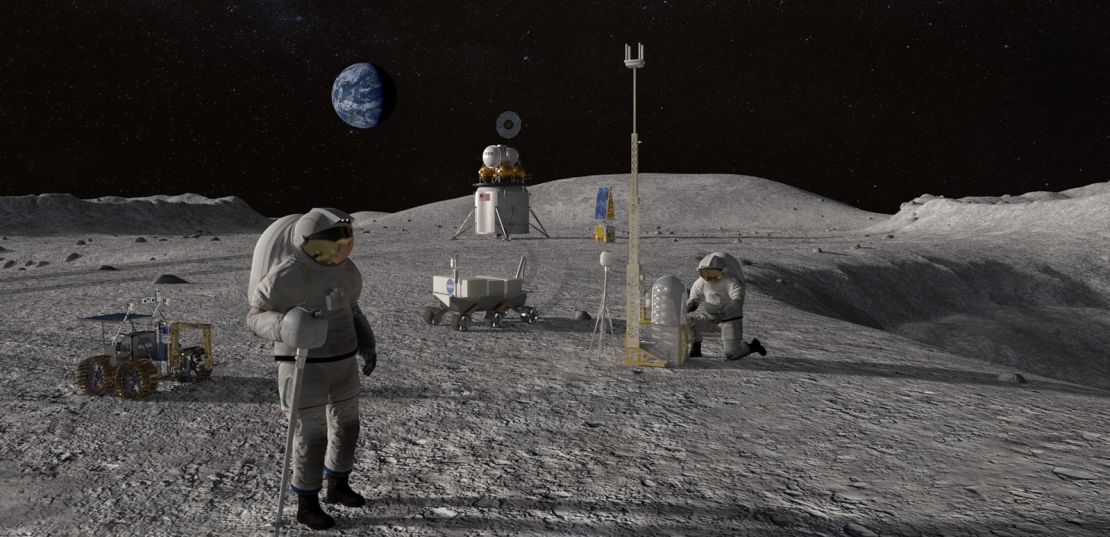The first woman and the next man will land on the moon’s south pole in 2024 through NASA’s Artemis program.
When they explore this part of the moon that has never been visited by humans before, these astronauts will build on the legacy and science gained during the Apollo program and carry it into a new century.
The agency released its science priorities and proposed activities by the astronauts for this first mission, called Artemis III, in a new report on Monday.
Artemis I will be an uncrewed flight test in November 2021 and Artemis II will be a crewed flyby of the moon in August 2023.
The Artemis III Science Definition Team has identified several priorities for this groundbreaking team. These include conducting experimental science on the moon, investigating and mitigating the risks of exploration, and understanding the origin of the elements at the lunar poles – like water and other resources that could be used by astronauts.
The agency also wants to establish an Artemis Base Camp by the end of the decade at the lunar south pole.

Another focus of the goals also includes a closer look at our local part of the solar system, like understanding the history of impacts between the Earth and moon to determine how the moon formed.
The goals also take a broader focus, like understanding planetary processes, how the moon and sun interact, and observing the universe from a unique vantage point.
The science team referred to the moon as “the cornerstone of the solar system” – a base from which scientists can understand more about our entire solar system.
The report identified strategies to meet these goals, like potential experiments, the type of samples the team wants the astronauts to acquire and the technology and resources that will be required.
“The Moon holds vast scientific potential and astronauts are going to help us enable that science,” said Thomas Zurbuchen, associate administrator for NASA’s Science Mission Directorate, in a statement.
“Even before Artemis III lands, our agency’s science and human exploration teams are working together as never before to ensure that we leverage each other’s strengths. This report helps outline a path forward toward the compelling science we can now contemplate doing on the lunar surface in conjunction with human explorers.”
Planning for a lunar return
Humans last explored the lunar surface during the final Apollo mission, Apollo 17, in 1972. And like the Apollo missions, when humans return to the moon, their time spent exploring the lunar surface will be packed full of experiments, sample collection, field geology and other activities.
What the astronauts learn from returning to the moon will enable the agency to plan for the first human mission to Mars.
Like the Apollo astronauts, the Artemis astronauts should be trained in geology and planetary science to help them when they’re collecting samples from the lunar surface as well as below it, the reported suggested.
The agency is interested in collecting more diverse samples from the moon compared to the Apollo missions. This includes frozen and sealed samples that could include evidence of water and other chemical resources, for a total sample collection that exceeds any of the previous Apollo missions.
Because Artemis III is a mission of firsts, the team pointed out that better power and communication systems will be required so they can monitor and speak with the astronauts, as well as receive data, on the moon in real time. The report authors also identified the need for a cache of tools or instruments awaiting the astronauts when they arrive – including a rover for mobility.
While NASA has one planned moonwalk for the Artemis III astronauts, the authors propose at least four to collect samples and conduct experiments.
The astronauts and the agency will also need better mapping capabilities than what is currently available to help avoid terrain-related risks on the lunar surface.
Artemis III isn’t expected to address all of the priorities in the report single-handedly, the authors said.
“But it will be a firm foundation for future discovery,” the authors wrote in the report. “Artemis III and subsequent Artemis missions will reach the lunar surface and conduct field work and fundamental research that will answer longstanding planetary science questions and redefine our understanding of the Solar System.”
Artemis III is essentially the beginning of “a new era of sustained exploration” envisioned by NASA. The moon also holds appeal as an accessible hub of resources that could enable more human-based exploration outside of low-Earth orbit.
This report is just the beginning, the scientists said, which will grow more detailed as other aspects of the Artemis program are determined – like a landing site and the capabilities of the Artemis III mission. But the authors hope that science will be one of the main factors considered when choosing the exact landing site.
The science team identified what they believe to be key factors in choosing a landing site for the Artemis III astronauts, like enough illumination from the sun to provide enough solar power and light for experiments.
The team is also hoping for a site that has a range of craters varying in size and diverse areas for sampling and access to permanently shadowed regions where water ice may have been undisturbed for years.
“We wanted to bring together what was most compelling to the science community at the Moon with what astronauts can do on the lunar surface and how the two can mutually reinforce each other,” said team co-chair Renee Weber, chief scientist at NASA’s Marshall Space Flight Center, in a statement.
“The team’s hard work will ensure we’re able to take advantage of the potential of the Artemis III mission to help us learn from the Moon as a gateway to the rest of the solar system.”









